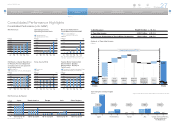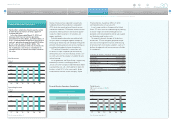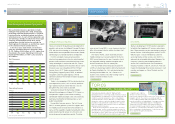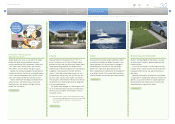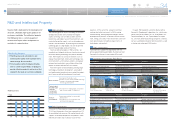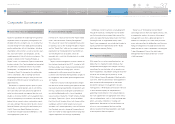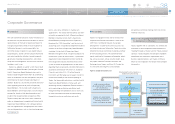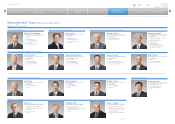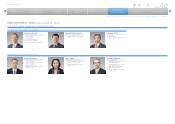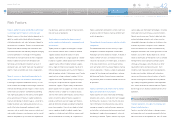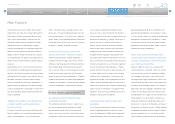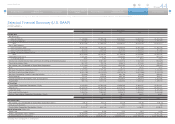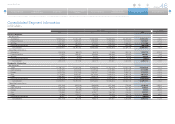Toyota 2014 Annual Report Download - page 36
Download and view the complete annual report
Please find page 36 of the 2014 Toyota annual report below. You can navigate through the pages in the report by either clicking on the pages listed below, or by using the keyword search tool below to find specific information within the annual report.
ANNUAL REPORT 2014
President’s MessagePresident’s Message
Overview of
Four Business Units
Overview of
Four Business Units
Special FeatureSpecial Feature
Review of OperationsReview of Operations
Consolidated Performance
Highlights
Consolidated Performance
Highlights
Management and
Corporate Information
Management and
Corporate Information
Investor InformationInvestor Information
Financial SectionFinancial Section
Page 36
NextPrev
ContentsSearchPrint
Corporate Philosophy
The Toyoda Precepts
•Alwaysbefaithfultoyourduties,therebycontributingtothecompanyandtotheoverallgood.
•Alwaysbestudiousandcreative,strivingtostayaheadofthetimes.
•Alwaysbepracticalandavoidfrivolousness.
•Alwaysstrivetobuildahomelikeatmosphereatworkthatiswarmandfriendly.
•Alwayshaverespectforspiritualmatters,andremembertobegratefulatalltimes.
1. Honor the language and spirit of the law of every nation and undertake open and fair business activities
to be a good corporate citizen of the world.
2. Respect the culture and customs of every nation and contribute to economic and social development
through corporate activities in their respective communities.
3. Dedicate our business to providing clean and safe products and to enhancing the quality of life every-
where through all of our activities.
4. Create and develop advanced technologies and provide outstanding products and services that fulfill
the needs of customers worldwide.
5. Foster a corporate culture that enhances both individual creativity and the value of teamwork, while
honoring mutual trust and respect between labor and management.
6. Pursue growth through harmony with the global community via innovative management.
7. Work with business partners in research and manufacture to achieve stable, long-term growth and
mutual benefits, while keeping ourselves open to new partnerships.
The Toyota Code of Conduct
Positioning of the CSR Policy
Toyota Global Vision
Medium- to long-term management plans
Company policies, annual policies, regional
policies, head office and divisional policies
Regular business activities
Guiding Principles at Toyota
CSRPolicy:
“Contribute to Sustainable Development”
Overview of Toyota’s CSR Activities
Education
Safety
Society
and
Cultures
Environment
Safety
Resources/
Energy
Sources
Comfort
and
Convenience
Environment
Compliance
Environmental
Aspect
Social
Aspect
Economic
Aspect
N Seeking Harmony between People, Society and the Global Environment as well as
the Sustainable Development of Society through Manufacturing
Since its foundation, Toyota has continuously strived
to contribute to the sustainable development of soci-
ety through the manufacturing and provision of innova-
tive, high-quality products and services that lead the
times. The automobile is a wonderful machine that
provides freedom of movement. Nevertheless, auto-
mobiles have an impact on the environment and soci-
ety. This is something we at Toyota always keep in
mind, and we try to create harmony among people,
societies and the environment by listening to what our
customers and local communities have to say. Our
operations are aimed at creating a sustainable society
through monozukuri (conscientious manufacturing).
Toyota develops and produces environment-friendly
vehicles such as hybrid vehicles, and we also offer
superior accident prevention and collision safety
features. In addition, Toyota is involved in new busi-
nesses, such as biotech, afforestation and renewable
energy. The pillars of our social contribution are
“environment,” “traffic safety,” and “human resources
development.” Toyota seeks to be of value to commu-
nities and to society through our main lines of busi-
ness, and to bring smiles to people’s faces. Toyota’s
basic Corporate Social Responsibility (CSR) policy is
to contribute to the sustainable development of soci-
ety. This phrase embodies the spirit of the Toyota
Guiding Principles, and clarifies our CSR stance for
our stakeholders, both within and outside the Com -
pany. Toyota subsidiaries and suppliers share this CSR
policy, and we expect them to adhere to the spirit of
the policy in their operations.
Toyota also participated in the formulation of
the Charter of Corporate Behavior of the Nippon
Keidanren (Japan Business Federation), which is an
alliance of Japanese leading corporations, and
observes the standards outlined therein.
N The Spirit of the Toyoda Precepts, Passed down since Toyota’s Founding
The Toyoda Precepts represent the essential philosophy of the founder of the Toyota group of companies, Sakichi
Toyoda, and are a source of spiritual support for Toyota employees.
N Toyota Guiding Principles
The Toyota Guiding Principles (adopted in 1992 and revised in 1997) reflect the kind of company that Toyota seeks to
be in light of the unique management philosophy, values, and methods that it has embraced since its foundation.
Toyota, along with its consolidated subsidiaries, seeks to contribute to the continuous development of human society
and of the planet through its businesses based on understanding and sharing the Toyota Guiding Principles.
Toyota’s Social Contribution Activities
Societal Issues
D Read more
Toyota Way 2001
R&D and Intellectual Property Corporate Philosophy Corporate Governance Management Team Risk Factors



